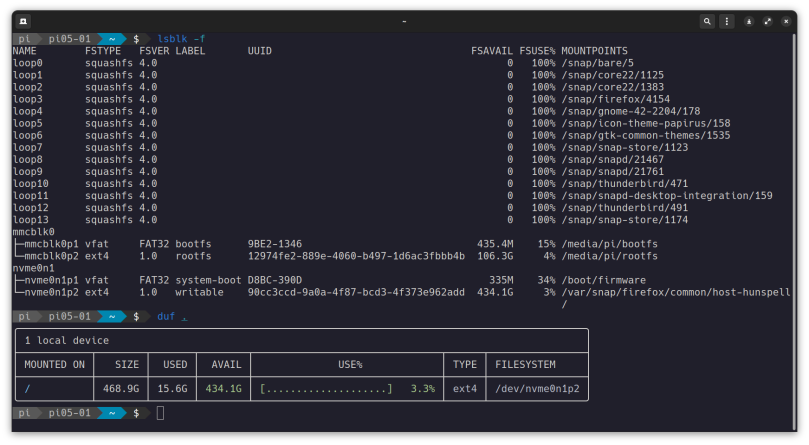
I finally broke down and took Jeff Geerling’s advice and migrated from using a micro SDXC drive as my boot device to using an M.2 2242 NVMe SSD. It wasn’t smooth sailing as I’ll explain below.
I started out with a third-party adapter that wasn’t the official Raspberry Pi adapter because the official Raspberry Pi adapter uses all the GPIO pins. Using the official adapter precludes the use of the GPIO pins for anything else. Unfortunately trying to use the third-party adapter turned out to be a mistake. So I purchased the official M.2 Hat+ along with a TIMETEC 512 GiB SSD and physically installed that on my Raspberry Pi 5. I tried to use Jeff Geerling’s rpi_clone to clone my Ubuntu 24.04 installation from the SDXC drive to the SSD, but that was a bust as it appears to only work with cloning the Raspberry Pi OS. I use Ubuntu 24.04 for aarch64, so it turned out to be a complete bust.
Plan B was to use the Raspberry Pi Imager to flash Ubuntu 24.04 onto the SSD, which is what I did. That, unfortunately, required me to boot into the fresh Ubuntu install and set it up all over again. That’s not such a problem for me, and since I’m recovering from my full left knee replacement surgery, it provided a bit of distraction during the healing process. I now have everything (nearly) back the way I had it using the SDXC card.
One annoying quirk I’ve discovered is that the only way to boot into the SSD with Ubuntu 24.04 installed on it is to have an SDXC card with Raspberry Pi OS still in the micro SDXC adapter. If I try to boot the Raspberry Pi 5 without that adapter filled then the Raspberry Pi 5 will not boot. It just sits there with an all-red screen. Put the SDXC card with Raspberry Pi OS back in and reboot, and it will boot and run off the SSD. And this is how the system looks after a boot:
 As you will note lsblk shows both devices, and that nvme0n1p1 is the boot device. It also shows the SDXC card is mounted in the system. The utility duf shows that the nvme0n1p2 is mounted as the root device.
As you will note lsblk shows both devices, and that nvme0n1p1 is the boot device. It also shows the SDXC card is mounted in the system. The utility duf shows that the nvme0n1p2 is mounted as the root device.
The photo at the top shows an unusual riser used to connect the M.2 hat to the Raspberry Pi. It shows a 90° extension that I hope will allow me to re-connect my external devices to the GPIO. Before I do that I’ll need to read the M.2 hat’s specifications and see which pins I need to avoid so that I don’t interfere with the proper operation of the hat, and thus, the SSD.
So far I’m reasonably satisfied. I don’t see any increase in speed, but I do notice that there is no long any little hesitations when the drive needs to be accessed. It also appears that the M.2 Hat+ is sitting high enough to let the active cooler do its job.
When I get the GPIO devices working I’ll write up a post about that adventure.
Links
Jeff Geerling — https://www.jeffgeerling.com

You must be logged in to post a comment.